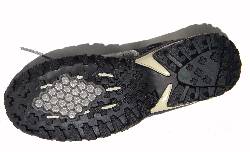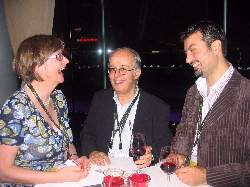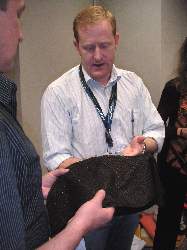Two posts from my Northampton blog posted on the the 10th and 27th
No blow with BASF
It’s Sunday and the sun is shining and we are just back from Lineapelle. I am sitting in the garden blowing through a tube sent to me by BASF. One moment it is easy and the next impossible to blow through it.
Now leather is outstanding in that it can hold large amounts of humidity without feeling damp, and this is superb for comfort since it allows a shoe lining, for example, to absorb all the perspiration that rushes from the foot in a moment and lets it evaporate in its own time. This stops moisture sitting against the foot, getting cold and creating discomfort. Of course you all know this, as it has been taught to us for the last 99 years (a little longer for those who are linked to Leeds).
What BASF have is a “superabsorbent”. This is a functional polymer made by via a joint association between BASF and IQTEX. I knew about IQTEX before as it was a winner a year ago in the sportswear accessories section of the Brand New awards at ispo. I was a member of the judges for quite a few years and was very sorry to have to give it up at the end of 2007.
The BASF and IQTEX product is the technical membrane Vayu Verde. The superabsorbent is a cross linked polyacrylate that can absorb up to 500 times its own weight in water. Not 20 or 25% like leather or even the much higher amounts that chamois can hold but 500%. And superabsorbents do not release water under pressure. So the Vayu Verde fleece can be as “air-permeable as a cotton T-shirt or as watertight as rain boots” according to Michael Dehn the managing director of IQTEX.
If you get the fleece suddenly wet the superabsorbent immediately swells and seals the system, staying watertight even under very high pressure. Then the material soon dries and regains its breathability. So what I have is my little tube with the fleece forming one wall and a spray bottle of water. Blow when it is dry and the air rushes through, no problem. Spray water on the fleece bit and nothing gets through no matter how hard you blow, how beetroot you become.
So sit back and enjoy the white wine in the sun, and then after a few minutes the fleece has dried and blowing is easy. Remarkable. Vayu Verde fleece is marketed by BASF as Luquafleece. Expect to see Vayu Verde in shoes from Baak and Elefanten before the end of the year. It will then roll out in garments, gloves and helmets.
BASF also indicate that one use of superabsorbents is the storage of water underground as plant roots are able to absorb the water stored in them slowly and evenly. Clever idea for arboriculture in Ethiopia.
Mike Redwood
27th April 2008
POSTED ON
Thursday 10 April, 2008
The APLF in Hong Kong is always an important venue for the leather industry albeit with the absence of most of the chemical companies and the rising importance
Most importantly we had a superb Corium Club event with a larger attendance than last year and a really good atmosphere. Huge thanks are due to Union Specialties for their sponsorship. The return to drinks and nibbles being carried round on trays by staff was a big success and the only speech was a short update from Dr Wilkinson. One older member that everyone enjoyed talking to was Tomas Mingo from Cueroflex in Buenos Aires.
All three staff from Northampton got involved in the APLF Awards which was easier to do since we did not have a stand and could walk the show. APLF gave each of us a “runner” who walked with us and collected the entries so time was used efficiently. There was a change in the awards this year as the entries were better and there was much more argument amongst the judges as we honed in on the real values of technology and the environment.
The best leather award went to Marmara Deri San Ve Tic of Turkey, for their beautiful 3-dimensional lamb nappa that is an interesting hybrid of leather and textile making it a perfect example of couture leather. This leather had been embossed, buffed, then dyed (we think) to give a clever raised appearance. Technically clever and very beautiful.
The Best New Materials Technology prize was given to Incusa of Spain, for taking the long-time theoretically known titanium-tanning process and succeeding in creating commercially viable, non-toxic, anti-allergenic leathers. Their Sanotan leather really looks and feels good while offering a bundle of features and benefits to the final consumer and some great points of differentiation for marketing. Titanium has often been considered, usually rejected and here they have made a commercial success of it.
The Best Ecological Product was awarded to Hammann Lederfabrik of Germany, for their leading-edge “cradle to cradle” approach to leather tanning. This leather was discovered by our Indian colleague Mr Sadiq from the CLRI and we had to go and interview the tannery to be sure that it really was a “cradle to cradle” leather. It was fascinating to see this development when we have just been reading Cradle to Cradle: Remaking the Way We Make Things by William McDonough and Michael Braungart and it was only two months ago that I listened to Michael Braungart lecture and attended his workshop. “Durability is a design tyranny: a guilt protection”, “carbon neutral is boring”, “remaking the way we make things”, “the biomass of ants is 4 times that of humans and this is not a problem – except when they are in your apartment – as everything they do adds to the benefit of the planet”, “its good that people are on the planet”, “we should not apologise every day that we are here”, “cradle to grave approach of maximum efficiency and zero waste is bad; the reverse is good”, “the tree is inefficient but its waste is food for others; it produces far too many blossoms but those not used benefit the planet in a different way”.
The Hamman leather uses leaves and nuts so that the tree is not damaged and is fully thought through on a cradle to cradle basis.
Also linked to this concept was the Best Alternative Materials award given to Chun Wang Brothers of Thailand, for their creative and colourful proposals of exotic materials including skins of fish, toads, frogs, chicken feet, eels and snakes, among others. The Cradle to Cradle institute promotes fish skin – from Icelandic Leather in Iceland who use farmed salmon – as a sustainable resource. Chun Wang use a mix of farmed and non farmed skins (all under the CITES convention which every exhibiter must sign) and were showing some really advanced leathers. The fish skin the judges liked was from a Tilapia (rather like a salmon). They are currently fished and the tannery discovered the skins were thrown away. The leather they made from this was thick and strong and looked as though it could offer much more divers end uses than the simple leathergoods that we see most often. The view of the judges is that the leather trader needs to use more alternate materials like kangaroo, yak, and camel from sustainable well considered suppliers and that Chun Wang were showing how this can be well done technically. Long term growth in hide supply looks likely to be limited by land shortage – already noticeable in China and Brazil – so these other materials should not be ignored.
Mike Redwood
10 April 2008


